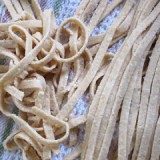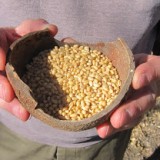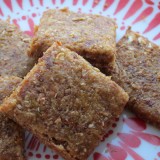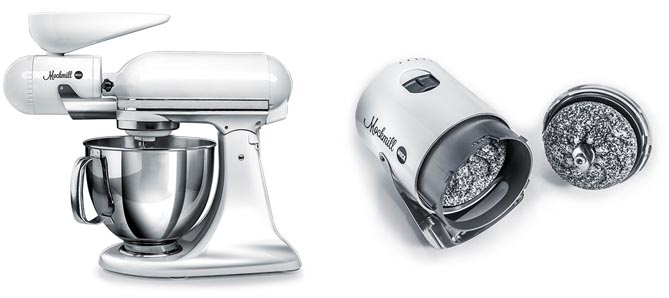
My review of the KoMo FlicFloc grain flaker was featured on Cool Tools and, in the comments, got some push back on the price. At $169 USD (from Pleasant Hill Grain or The King’s Roost), it’s a fair objection.
A number of commenters pointed out that you can buy grain crackers such as the one on the right for around $20 to $30 USD. I had one of these crackers for years (it’s headed to the thrift store on account of our recent decluttering). I’ve never liked it. It’s poorly made. The hopper never fit onto the rest of the unit. It must be disassembled to clean.
Most importantly, here’s the difference when flaking oats between my inexpensive grain cracker and the FlicFloc:

On the left are some oats run through the cracker versus oats, on the right, run through the FlicFloc. A cheap cracker is fine for cracking corn for chicken feed or making a course grind of rye for a Scandinavian style bread, but it does not make either flour or truly flaked grains. The FlicFloc flakes oats and cracks wheat and rye and it’s easy to clean.
I’ve never regretted paying more for a tool that will last a lifetime. I have regretted, many times, buying cheap tools. The FlicFloc broke my Grape Nuts addiction. It will pay for itself.





Thanks for the information. There aren’t a lot of reviews for this product out there. One Amazon reviewer complained about the difficulty of getting the oats to feed into the gears properly. She says it takes 15 minutes to fill the glass receptacle. Has this been a problem for you, and if so, how do you handle it?
Also, do you have a favorite muesli recipe you’d be willing to share? I’m trying to recreate a European version I ate occasionally as a child. So far, no luck.
Donna, I saw that review too and was puzzled by it. I do give the oats a nudge with my finger. And 15 minutes? It takes me around a minute for a small bowl. As for muesli, here’s what I’ve been doing: oats, some cacao nibs, walnuts or whatever nuts we have around, a few raisins, yogurt and some fresh fruit.
When I first reached the point where I started acquiring tools, my dad told me about a strategy he says he learned from the Whole Earth Catalog – start by buying the cheaper tool. If it breaks or you hit a point where it becomes inadequate for the job, THEN look into the higher-quality tool. I think your breakfast cereal habit clearly justifies the higher-quality tool in this case. In some cases, though, it remains worthwhile to experiment with something cheaper/less fancy, especially if that’s the difference between balking over something and actually getting started with the thing. This happens a lot when people want to start bicycling, for instance (although with bicycles many people have to be cautioned against things that are *too* cheap and terrible, which will dissuade them from bicycling).
I used one of those cheaper corn-crackers for a science experiment for a while (grinding up corneal for ants). I agree with you on its quality and how hard it is to clean.
Pingback: Cool Tools – KoMo FlicFloc Flaker
Rebecca,
That is how I ended up with a $200+ Excalibur. I bought the cheap $30 one at WM first. I broke all but one tray in one fell swoop when they slid off the counter. Then, I bought one at a yard sale to get more trays cheaply. Finally, I heard about Excalibur and how the things I did not like were solved with Excalibur–rotating trays, uneven drying–plus other things. I am supremely happy now.
I bought any old kind of strainer for years. Finally, I tired of them tearing up or rusting and wandered into a store in town that carries very expensive housewares. It felt like I was being uppity, putting on airs, and buying where the wealthy shop when I paid $10 from a 3″ strainer Made in France. It looks like new, not shredded or rusted or pulled loose from the rim. I have had it for 15 years and expect it to last another 15 years. Before this strainer, I was buying one every year or so.
I assume the oat and other grains require some kind of cooking or soaking procedure before being flaked?
I read cereal grains are not easy to digest if eaten raw.
Thanks!
We flake the oats raw and eat them raw. It works for us. The Internet is split on the subject of raw oats. Of course, muesli is made of raw oats. We wouldn’t eat other grains raw though, and we don’t eat heaping bowls of raw oats. Our breakfast is yogurt with oats, nuts, raisins, etc. mixed in. On a romantic note, I recall hearing somewhere that Roman legionaries marched on handfuls of oats–raw oats were one of their basic rations. Don’t know if it’s true!
Thank you for the reply!
Roman legionaries were definitely known for their strength and endurance 🙂
I am not so certain that oats in muesli are raw. On Wikipedia it says muesli is based on raw rolled oats but then when you read what rolled oats are it says they are oats steamed and then rolled followed sometime by light baking.
I found this description on most sources describing rolled oats production. I believe the flakes sold it the grocery shops are indeed all steamed. Anyway good to know that for you raw flakes seem working.
Hi! This post is a little old, but I suddenly have a burning question that the internet at large cannot answer for me: have you ever tried to process wild rice in this contraption? I’m playing with ideas for a wild foods take on muesli or granola. If it was first lightly steamed, maybe?
Good question! I just put a few grains of wild rice through the flicfloc for the heck of it, and as you might expect it sort of shattered the rice, and the texture is quite hard. I’m thinking it might work if you steamed and then dehydrated the rice. If not, I’d worry the wet rice would gum up the mechanism.
The Flic Floc manual recommends soaking all grains other than oats before running them through. I imagine this will work with rice but I’ve never tried it.